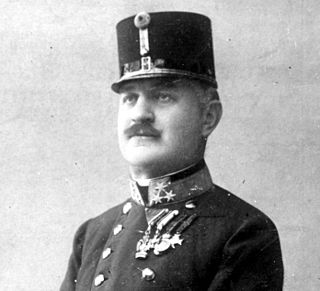
Alfred Redl was an Austro-Hungarian military officer who rose to head the Evidenzbureau, the counterintelligence wing of the General Staff of the Austro-Hungarian Army. He was one of the leading figures of pre-World War I espionage; his term in office was marked by radical innovations and the use of advanced technology to ensnare foreign spies.
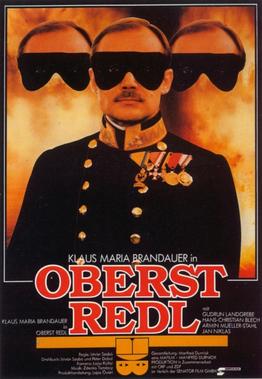
Colonel Redl is a 1985 biographical drama film by Hungarian director István Szabó. The plot, set in the period before World War I, follows the rise of Alfred Redl, an officer in the Austro-Hungarian Empire. Redl, who comes from a humble background, enters military school as a boy and an illustrious military career comes his way by virtue of his loyalty to the crown. He is appointed the head of an intelligence-gathering unit, but his attraction to men eventually causes his downfall.

Spione is a 1928 German silent espionage thriller directed by Fritz Lang and co-written with his wife, Thea von Harbou, who also wrote a novel of the same name, published a year later. The film was Lang's penultimate silent film and the first for his own production company; Fritz Lang-Film GmbH. As in Lang's Mabuse films, Dr. Mabuse: The Gambler (1922) and The Testament of Dr. Mabuse (1933), Rudolf Klein-Rogge plays a master criminal aiming for world domination.

Der Kongress tanzt is a German musical comedy film produced in 1931 by Ufa, directed by Erik Charell, starring Lilian Harvey as Christel Weinzinger, the glove seller, Willy Fritsch as Tsar Alexander I of Russia and his doppelgänger, Uralsky, Otto Wallburg as Bibikoff, his Adjutant, Conrad Veidt as Prince Metternich, Carl-Heinz Schroth as his Secretary, Pepi, Lil Dagover as the Countess and Alfred Abel as the King of Saxony.

The k.u.k. Evidenzbureau was the directorate of military intelligence of the Austro-Hungarian Empire, headquartered in Vienna, Austria.
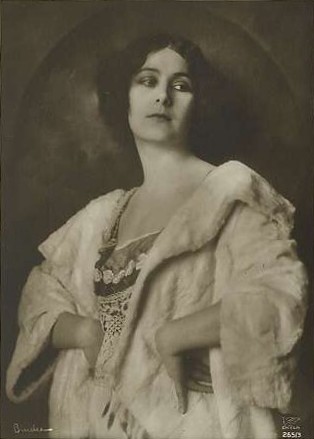
Lil Dagover was a German actress whose film career spanned between 1913 and 1979. She was one of the most popular and recognized film actresses in the Weimar Republic.

Bismarck is a 1940 German historical film directed by Wolfgang Liebeneiner and starring Paul Hartmann, Friedrich Kayßler, and Lil Dagover.
Vienna 1910 is a 1943 German biographical film directed by Emerich Walter Emo and starring Rudolf Forster, Heinrich George, and Lil Dagover. It is based on the life of Mayor of Vienna Karl Lueger. Its antisemitic content led to it being banned by the Allied Occupation forces following the Second World War.
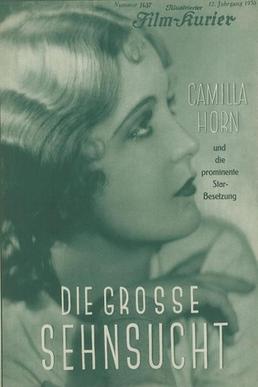
The Great Longing is a 1930 German comedy film directed by Steve Sekely in his directorial debut and starring Camilla Horn, Theodor Loos, and Harry Frank. It was shot at the EFA Studios in Berlin. The film's sets were designed by the art directors Hans Sohnle and Otto Erdmann. It was distributed by the German branch of Universal Pictures.

Tales from the Vienna Woods is a 1979 Austrian-German drama film directed by Maximilian Schell. The film was adapted from the play by Ödön von Horvath. It was selected as the Austrian entry for the Best Foreign Language Film at the 52nd Academy Awards, but was not accepted as a nominee. It was the final film for veteran actress Lil Dagover who started her film career in the 1910s.

The Higher Command is a 1935 German historical film directed by Gerhard Lamprecht and starring Lil Dagover, Karl Ludwig Diehl and Heli Finkenzeller. Produced and distributed by UFA, it was shot at the company's Babelsberg Studios in Potsdam. The film's sets were designed by the art directors Otto Erdmann and Hans Sohnle.

Chronicles of the Gray House is a 1925 German silent historical drama film directed by Arthur von Gerlach and starring Paul Hartmann, Rudolf Forster and Lil Dagover.
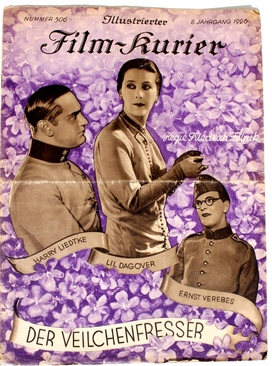
The Violet Eater is a 1926 German silent comedy film directed by Frederic Zelnik and starring Lil Dagover, Harry Liedtke and Ernö Verebes. It was shot at the Staaken Studios in Berlin. The film's sets were designed by the art director Andrej Andrejew. It premiered at the Marmorhaus in Germany's capital.

Madame Bluebeard is a 1931 Austrian drama film directed by Conrad Wiene and starring Lil Dagover, Harry Frank and Otto Hartmann.

Colonel Redl is a 1925 Austrian silent drama film directed by Hans Otto and starring Robert Valberg, Eugen Neufeld and Harry Norbert. It portrays the career of the Austrian Army Officer Alfred Redl, exposed as a foreign agent shortly before the First World War.
Power of Temptation is a 1922 German silent film directed by Paul L. Stein and starring Lil Dagover, Ilka Grüning and Arnold Korff.
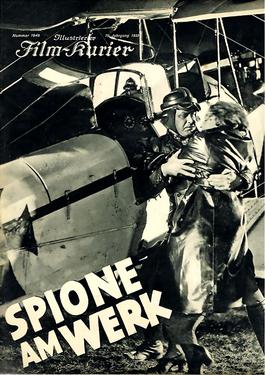
Spies at Work is a 1933 German thriller film directed by Gerhard Lamprecht and starring Karl Ludwig Diehl, Brigitte Helm, and Eduard von Winterstein. A spy film, it is set during the First World War conflict between Austria and Italy.

The Happiness of Grinzing is a 1933 Czech musical film directed by Otto Kanturek and starring Iván Petrovich, Gretl Theimer and Alfred Gerasch. It was produced in German and several of the cast and crew had recently left Germany following the Nazi takeover there. It was shot at the Barrandov Studios in Prague. The film's sets were designed by the art director Bohumil Heš. A separate Czech-language version, In the Little House Below Emauzy, was also shot at the same time. Such multiple-language versions were common during the early years of sound film before dubbing became more widespread. In German-speaking parts of Czechoslovakia it was released under the title Das Häuschen in Grinzing.
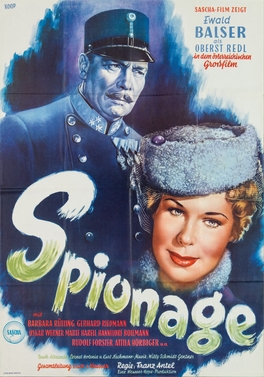
Espionage is a 1955 Austrian historical spy drama film directed by Franz Antel and starring Ewald Balser, Barbara Rütting and Gerhard Riedmann. It was shot at the Sievering Studios and on location in Vienna. The film's sets were designed by the art director Felix Smetana. It was based on the real story of Alfred Redl, an officer serving with Austrian Military Intelligence who was also secretly spying for the hostile Russian Empire before the First World War.
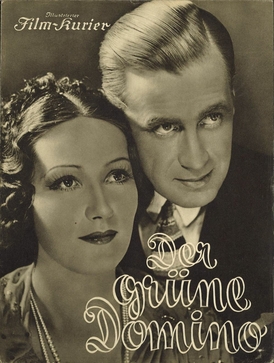
The Green Domino is a 1935 German mystery drama film directed by Herbert Selpin and starring Brigitte Horney, Karl Ludwig Diehl and Theodor Loos. It was shot at the Babelsberg Studios in Berlin and on location in Bavaria around Munich and the Tegernsee. The film's sets were designed by the art directors Otto Hunte and Willy Schiller. It is based on the novel Der Fall Claasen by Erich Ebermayer. A separate French-language version Le Domino vert was also produced, directed by Selpin and Henri Decoin but featuring a different cast.


















